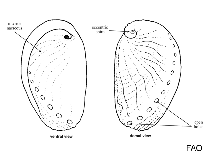Haliotis sorenseni Bartsch, 1940
White abalone| Native range | All suitable habitat | Point map | Year 2050 |

|
| This map was computer-generated and has not yet been reviewed. |
| Haliotis sorenseni AquaMaps Data sources: GBIF OBIS |
Google image | No image available for this species;
drawing shows typical species in Haliotidae.
Classification / Names Common names | Synonyms | CoL | ITIS | WoRMS
Gastropoda | Lepetellida | Haliotidae
Environment: milieu / climate zone / depth range / distribution range Ecology
Benthic; depth range 20 - 66 m (Ref. 101453), usually 43 - 60 m (Ref. 101453). Subtropical; 34°N - 26°N, 121°W - 112°W
Distribution Countries | FAO areas | Ecosystems | Occurrences | Introductions
Eastern Pacific: USA to Mexico. From Point Conception, California to Punta Abreojos in Baja California.
Length at first maturity / Size / Weight / Age
Maturity: Lm ?, range 9 - 13.4 cm Max length : 25.0 cm TL male/unsexed; (Ref. 865); max. reported age: 40 years (Ref. 105226)
Life cycle and mating behavior Maturity | Reproduction | Spawning | Eggs | Fecundity | Larvae
Main reference
References | Coordinator | Collaborators
Bisby, F.A., M.A. Ruggiero, K.L. Wilson, M. Cachuela-Palacio, S.W. Kimani, Y.R. Roskov, A. Soulier-Perkins and J. van Hertum 2005 Species 2000 & ITIS Catalogue of Life: 2005 Annual Checklist. CD-ROM; Species 2000: Reading, U.K. (Ref. 19)
IUCN Red List Status
(Ref. 130435: Version 2025-1)
CITES status (Ref. 108899)
CMS (Ref. 116361)
Threat to humans
Human uses
Fisheries: commercial
| FishSource |
Tools
More information
Max. ages / sizes
Length-weight rel.
Length-length rel.
Length-frequencies
Mass conversion
Abundance
Internet sources
BHL | BOLD Systems | CISTI | DiscoverLife | FAO(Publication : search) | Fishipedia | GenBank (genome, nucleotide) | GloBI | Gomexsi | Google Books | Google Scholar | Google | PubMed | Tree of Life | Wikipedia (Go, Search) | Zoological Record



